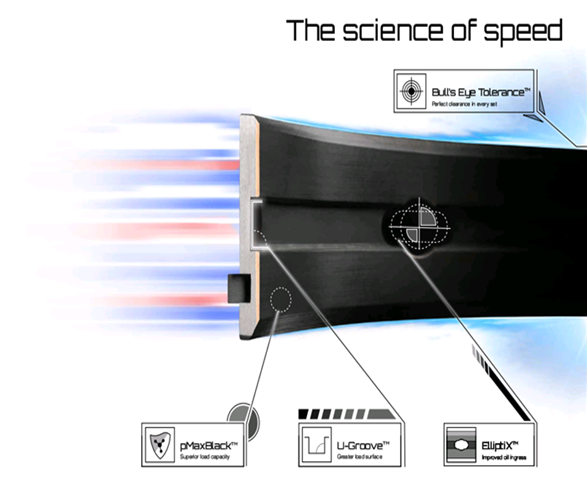Main page
About us
Sliding Bearings Consulting
Advertising Opportunities

SubsTech’s sister website Smooth Sliding provides independent engineering consulting services that help you to solve engine bearing related issues: failures, material selection, geometry design and optimization of hydrodynamic conditions.
Smooth Sliding is an engineering consulting company run by Dr. Dmitri Kopeliovich:
- VP R&D of King Engine Bearings.
- World leading expert (32 years of experience) in design, technology and materials for Engine bearings in applications such as automotive, renewable energy, aviation, racing and others.
- Founder and owner of SubsTech (Substances & Technologies) – a leading professional website on Materials Science and Engineering.
- Author of numerous scientific and engineering publications and patents.
- Founder and owner of Smooth Sliding.
For further information and for requesting consulting services please visit our sister website Smooth Sliding.
to Metals
to Engine bearings
U-Groove™ Modified Design of Oil Groove for High Performance Bearings
Introduction
The loads acting on engine bearings are generated by the pressure of the fuel-air mixture combusting in the cylinders. This pressure, or combustion force, drives the piston down during the engine power stroke. The piston is connected to the crankshaft by the connecting rod, which transmits the load and converts the linear motion of the piston into crankshaft rotation.
The upper connecting rod bearing is the first bearing supporting the load generated in the cylinder. Since the crankshaft is supported by the main bearings, they react to the load transmitted via the connecting rod bearings. In the simplest one-cylinder engine there are two main bearings supporting the crankshaft, and the load from the cylinder pressure is directed onto these two lower main bearing shells.
However, combustion force is not the only force generated by an internal combustion engine. Such engines contain parts performing accelerating/decelerating motion (either linear or rotating): pistons, connecting rods, crankpins, counterweights and webs of the crankshaft. These parts generate inertia forces that are added to the combustion forces and therefore affect the support reactions of the bearings.
The value of the inertia force produced by a moving part is proportional to the square of the rotation speed. At low and medium rotation speeds the inertia forces are relatively low. Therefore the most loaded part of a connecting rod bearing is the upper shell, and the most loaded part of a main bearing is the lower shell.
However at high rotation speeds, which are characteristic of high performance engines, inertia forces become considerable. For example, an increase of rotation speed from 2000 to 6400 RPM raises the inertia forces by 10 times.
In high performance engines inertia forces are comparable to combustion forces and may even exceed them.
to top
Effect of the Oil Groove on Bearing Function
The inertia force generated by a rotating part of the crankshaft is directed from the rotation center to the center of mass. Therefore it is transmitted to both the upper and lower main bearing shells. The oil groove is commonly made in the upper shell where the oil hole is located. A 180º groove is sufficient for providing the required amount of oil to the connecting rod bearing, which it reaches by flowing through passageways within the crankshaft.
The lower main shell has no groove. Therefore its effective area is greater than that of the upper grooved bearing. This design allows distributing the load applied to the lower shell over a greater area, reducing the specific load acting on the bearing material. Since the lower bearing shell is generally loaded heavier than the upper, the specific loads of the two are balanced.
However, at high rotation speeds in high performance engines the absolute loads applied to the upper and lower bearings may become close to each other. In this case the specific load (force per unit area) applied to the upper bearing may exceed the specific load to the lower bearing.
Excessive loading of the upper bearing may cause the following two problems:
- Fatigue of the bearing material. Internal combustion engines are characterized by cycling loading of the bearings. It is caused by alternating pressure of combustion gases in the cylinders and inertia forces developed by accelerating parts. The oscillating loads applied to a part may cause bearing failure as a result of material fatigue [1]. This occurs if the load exceeds the Fatigue strength (load capacity) - the maximum value of cycling stress that a bearing can withstand after an infinite number of cycles.
- Too low minimum oil film thickness. High loads applied to the bearings result in a reduction of minimum oil film thickness. This may cause non-uniform distribution of the bearing load (localized pressure peaks) [2] characterized by metal-to-metal contact between the bearing and shaft (mixed or boundary lubrication regime), high coefficient of friction (power loss), increased wear, and the possibility of seizure between the bearing and shaft materials.
New Design of Oil Groove (U-Groove™)
The level of specific load applied to the grooved bearing may be lowered by means of a reduction in groove width.
Fig.1 shows a cross section of a bearing with a conventional oil groove design.
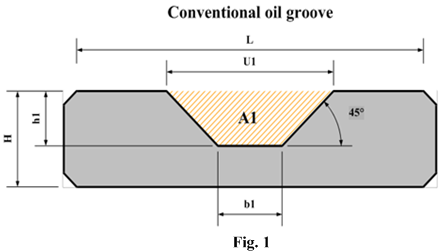
The effective bearing length is L-U1. It may be increased by a simple decrease of U1, but it would reduce the cross sectional area of the groove. This is an extremely undesirable modification, particularly for high performance bearings generating high oil flow rates due to operation at high rotation speeds. The connecting rod bearing is lubricated by oil passing through the main bearing groove and then the oil passages in the crankshaft. The amount of oil entering the connecting rod bearing should be not lower than the oil flow produced by the hydrodynamic lubrication of the main bearing. A reduction of the cross sectional area decreases the passage capability of the groove, which may cause a formation of oil starvation conditions in the connecting rod bearing.
A new design should result in a reduction of the groove width without decreasing the groove cross sectional area.
The modification according to these demands is presented in Fig.2.
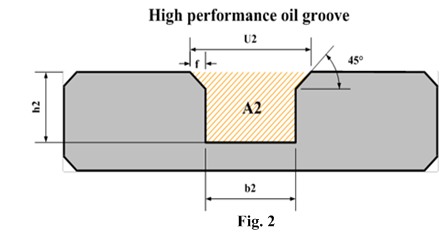
The rectangular shape with small chamfers has allowed reduction of the groove width at the top (U) by at least 30%. On the other hand the cross sectional area A has not changed due to an increase of both groove width b and groove depth h.
to top
Comparative Hydrodynamic Calculations
The parameters of hydrodynamic lubrication of bearings with the modified groove design in comparison with conventional bearings were theoretically calculated using software developed by King Engine Bearings. The program is capable of calculating loads, minimum oil film thickness, oil temperature rise, energy loss, oil flow rate and other thermodynamic, dynamic and hydrodynamic parameters for each bearing of an engine at any angular position of the crankshaft.
A race car engine equipped with high performance King CR 807XPN (connecting rod bearings) and MB 557XP (main bearings) was taken as an example for these calculations. The calculations were made at an engine operation of 5000 RPM.
The results of the calculation of bearing specific load for a full cycle of the four stroke engine (720º) are presented in Fig.3.
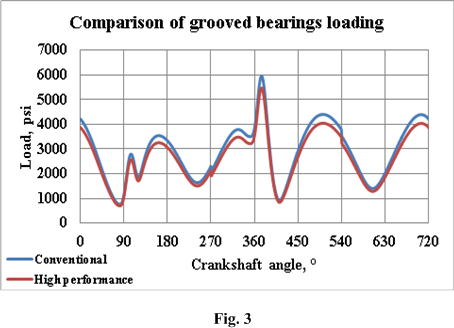
The greater effective area of the modified (high performance) bearing resulted in lower loads as compared to the bearing with the conventional groove design. The values of the maximum loads are shown in Fig.4.
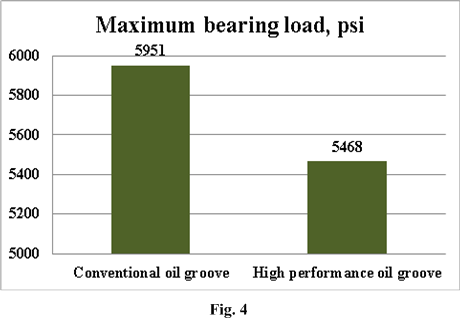
The most important benefit from lowering the maximum specific load applied to the bearing is an increase in the reliability of the bearing. This is due to a lower probability of the formation of fatigue cracks in the overlay.
The specific load is not evenly distributed over the bearing surface. The distribution has a peak located in the region of minimum oil film thickness. The value of the peak is dependent on many parameters: the value of the average specific load, oil clearance, bearing eccentricity, rotation speed, oil type and its temperature.
Among similar bearings operating under the same load, the bearing with the higher peak oil film pressure has a maximum probability to fail due to fatigue of the material in the area of the peak.
The two bearing oil groove designs have been compared in terms of peak oil film pressure. The results of the calculations for a full cycle of the four stroke engine (720º) are presented in Fig.5.
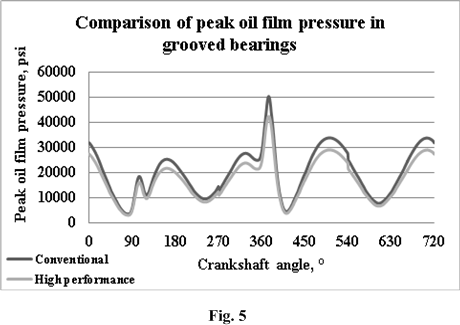
As seen from the graphs, the new groove design provides lower values of peak oil film pressure at any position of the crankshaft. The difference between the two designs is the most significant (~15-20%) when the specific load reaches the maximum values (Fig.6).
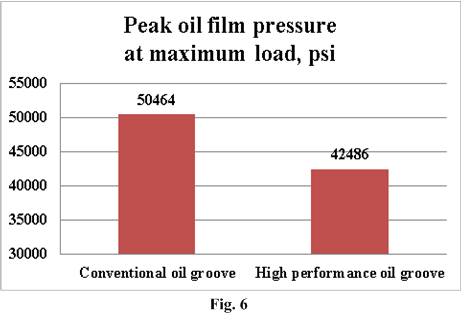
Another parameter responsible for stable and durable operation of a bearing is minimum oil film thickness, the value of which determines the hydrodynamic character of lubrication. If the oil film thickness is lower than the heights of the micro-asperities (Rz) on the bearing and journal surfaces, the lubrication regime becomes mixed (not purely hydrodynamic). The mixed lubrication regime is characterized by an increased probability of failure due to localized load, increased wear, and seizure.
Fig.7 and 8 demonstrate the results of the calculation of minimum oil film thickness for the example engine.
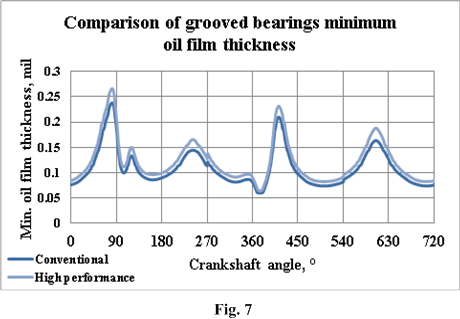
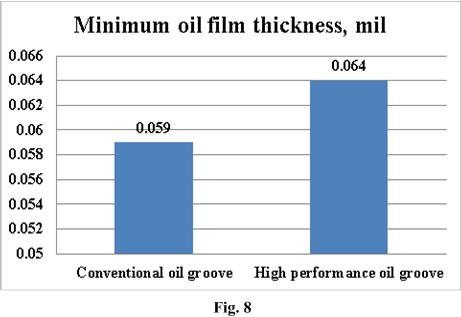
The modified groove for high performance bearings enables bearing operation with a thicker oil film. In spite of the fact that the difference is not as large as in peak oil film pressure, it may become crucial under conditions characteristic for high performance engines: high loads, low viscosity oils and high rotation speeds.
to top
Validation of the Modified Oil Groove Design
The bearings with two different designs of oil groove (conventional and high performance) were tested by two different methods:
- Test Rig
- Dynamometer
a. Validation of the New Groove Design in Test Rig Machine
The tests were performed in the test rig designed and manufactured by King Engine Bearings (Fig.9)
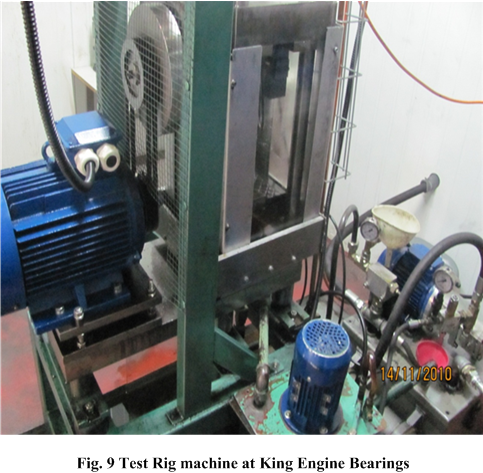
The test rig uses an eccentric shaft located between two concentric shaft parts. The test bearing, coupled with the eccentric shaft, is mounted in the big end of the connecting rod. Rotation of the eccentric shaft results in reciprocating motion of the connecting rod [3].
The shaft is driven by an electric motor. The rotation speed of the test rig may be varied within the range 1500-5000 RPM. Load is created by a hydraulic cylinder.
The experimental bearings (upper shells of M 557XP) with two different groove designs were tested under a reciprocating load of 15,400 lbs. This is equivalent to the 9,820 psi specific load of the modified groove bearing and the 10,700 psi specific load of the conventional groove bearing.
Test duration: 24 hrs
Rotation speed: 3000 RPM
Number of cycles: 4,300,000
Rig tests results:
The bearing with the conventional groove design finished the tests without any failure. The bearing surface has slight marks of wear at the bearing edges. There is no sign of seizure. In the central part of the bearing there is a small area with fatigue cracks in the overlay (Fig.10). There is also a slight wear of the overlay surface. The cracks are very small and did not adversely affect bearing operation. However the fatigue process has started, and it may cause a bearing failure in further operation.
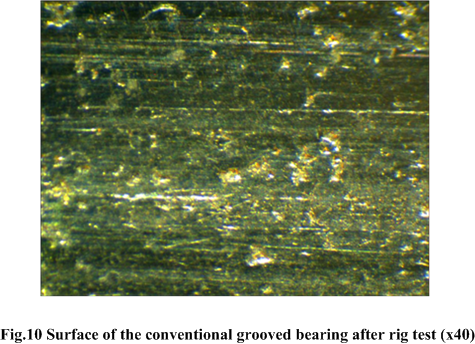
The bearing with the modified groove design also finished the test without failure. Its appearance is very similar to that of the conventional bearing, with the difference that it has no fatigue cracks on its surface. Also, there is no wear of the overlay surface (Fig.11).
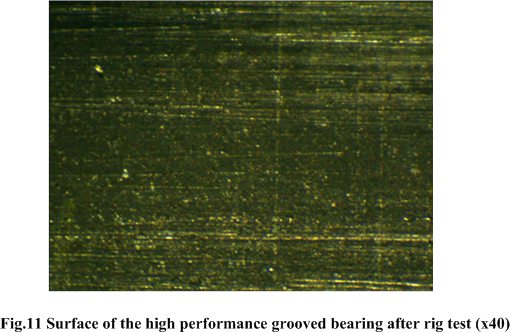
The difference in the results between the conventional and modified groove bearings is explained by the difference in the specific loads applied to the bearing material. The load to the conventional bearing was above 10,200 psi whereas the load to the modified bearing was below 10,200 psi, due to its new design groove.
Such test conditions were chosen deliberately since 10,200 psi is the load capacity of King XP material. Therefore the conventional groove bearing was overloaded during the test, which resulted in formation of fatigue cracks. On the other hand, the bearing with the modified groove design operated at load levels below the load carrying capacity of its overlay. Therefore fatigue cracks did not form.
b. Validation of the New Groove Design in Dynamometer
The tests were performed using King’s Power Test dynamometer.
Purpose: to compare overlay reactions and wear rate of conventional and modified groove bearings, without causing catastrophic failure.
Tested engine: high performance Chevy 355.
King CR 807XPN (connecting rod bearings) and MB 557XP (main bearings) were installed in the engine. Three of the main bearings (including the flange bearing) were manufactured with the new design groove; the remaining two bearings had the conventional design.
The test conditions:
Torque: 400 ft-lb
Rotation speed: 5000 RPM
Power: 380 HP
Test duration: 100 hrs
Number of cycles: 30,000,000
The test results:
The main bearings (upper and lower shells) had no signs of fatigue or seizure. Visual examination revealed a larger area of Metal-to-metal contact in the upper bearings with the conventional design groove than in the bearings with the new groove design.
The bearings’ wear was determined by thickness and weight measurements.
The measurement results are presented in the table:
| Parameters | Conventional groove | High performance groove |
|---|---|---|
| Thickness reduction, µinch | 63 | 41 |
| Weight reduction, mg | 29 | 19 |
According to the measurements, the new design oil groove reduced overlay wear by 35%. This is due to greater oil film thickness, lower load and more uniform distribution of the oil film pressure.
to top
Conclusions
- A new design of oil groove (U-Groove™) for the upper main shells of high performance bearings has been developed by King Engine Bearings.
- The modified design results in an increase of the effective bearing area without a decrease of the cross sectional area of the groove.
- According to the theoretical calculations, and observed rig and dyno test results, the new design provides greater bearing durability due to lower specific loading and a more stable hydrodynamic lubrication regime: smaller peak oil film pressure and greater oil film thickness.
- The tests of the bearings in the test rig prove that, at loads close to the load capacity of the bearing material, the new design is capable of preventing failure due to fatigue of the overlay.
- The dynamometer test of the bearings under live engine operating conditions shows that the bearings have a lower wear rate due to the new design of the oil groove.
References
[1] Dmitri Kopeliovich (2013), Engine bearing failure, SubsTech (Substances&Technologies), Available from http://www.substech.com/dokuwiki/doku.php?id=engine_bearing_failure
[2] Dmitri Kopeliovich (2011), The Proper Selection of Engine Bearing Materials, AERA., April-June 2011, p.48-62.
[3] Dmitri Kopeliovich (2013), Engine bearing fatigue test, SubsTech (Substances&Technologies), Available from http://www.substech.com/dokuwiki/doku.php?id=engine_bearing_fatigue_test
to top
Related internal links
to Metals
to Engine bearings



